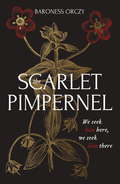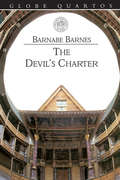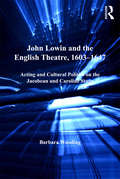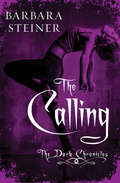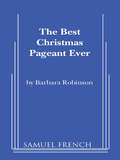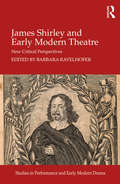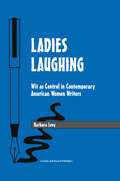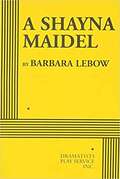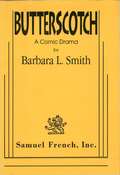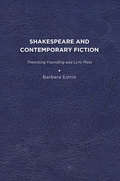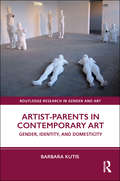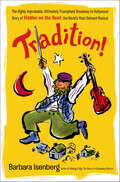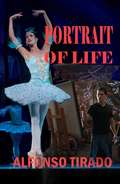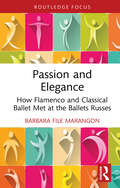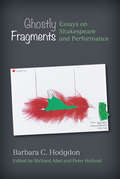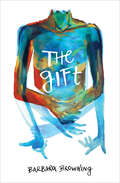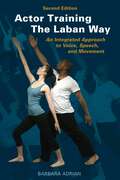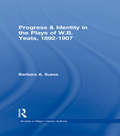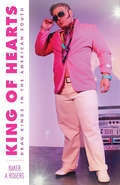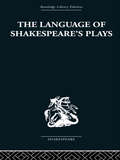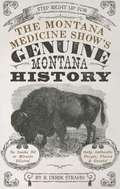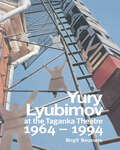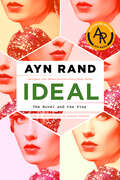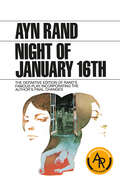- Table View
- List View
The Scarlet Pimpernel: Large Print (The Psammead Ser. #Vol. 1)
by Baroness OrczyBaroness Orczy's classic tale of adventure during the French Revolution. Also available as an unabridged audiobook, read by Julian Rhind-Tutt.Paris, 1792. The Terror has begun. Every day, scores of the French nobility are delivered to the guillotine. Trapped in the capital, they have no way of escape. But rumours abound of a league of young English gentlemen who are risking their lives to spirit French aristocrats away to safety across the Channel. Led by a man known only as the 'Scarlet Pimpernel', they leave no trace behind them save a single note. Determined to stop them, ruthless spymaster Chauvelin travels to England and embarks on a quest to uncover the identity of their leader, forcing the Scarlet Pimpernel and his men to summon all their courage and wits to evade capture and stay alive.PRAISE FOR THE SCARLET PIMPERNEL"Anyone who feels that their outward manner is but a travesty of their inner self can hardly fail to respond to THE SCARLET PIMPERNEL" - Independent"The Baroness Orczy invented the "masked avenger" genre of fiction - the swashbuckling hero of dual identity. Her progeny include Zorro, Superman, The Lone Ranger and many others." - Audiofile Magazine
The Devil's Charter: A Tragedie, Conteining The Life And Death Of Pope Alexander The Sixt (classic Reprint) (Globe Quartos)
by Barnabe BarnesFirst Published in 1999. Routledge is an imprint of Taylor & Francis, an informa company.
John Lowin and the English Theatre, 1603–1647: Acting and Cultural Politics on the Jacobean and Caroline Stage (Studies in Performance and Early Modern Drama)
by Barbara WoodingEven for scholars who have devoted their careers to the early modern theatre, the name John Lowin may not instantly evoke recognition-until now, the actor's life and contribution to the theatre of the period has never been the subject of a full-length publication. In this study, Barbara Wooding provides a comprehensive overview of the life and times of Lowin, a leader of the King's Men's Company and one of the greatest actors of the seventeenth century. She examines his involvement in the Jacobean/Caroline world as performer, citizen and company manager, and contextualizes his life and career within the socio-economic and political framework of the period. Although references to him in the archives are patchy and sporadic, information about his activities within the King's Men's Company is well documented. In the course of analysing less familiar plays of the period and the characters Lowin played in them, Wooding supplements critical understanding of the scope and range of Caroline drama. Because Lowin's career burgeoned after Shakespeare's and Burbage's death, his life in Southwark and his career with the same company furnishes the opportunity for an examination of the changing status of actors, and the exercising of their skills within the drama of the later playhouse period.
The Calling (The Dark Chronicles #3)
by Barbara SteinerMiki O'Ryan jumps at the chance to be part of a mysterious dance troupe--until she realizes its members may be more dangerous than they appear For several nights, Miki O'Ryan has snuck into the condemned Sullivan Theater to watch an enigmatic, shadowy group perform haunting routines that are part gymnastics, part dance, and part magic. When the director catches Miki spying one night, he invites her to join them. The Theater of the Dead is a gothic troupe whose members all pretend to be vampires. Miki is thrilled to finally belong to a family, however odd it may be. When the gorgeous Davin is assigned to be her partner--and seems as if he may be interested in being more--Miki is ready to follow the Theater of the Dead anywhere. But whenever Miki dances with them, she feels as if they are putting her under a spell with their sensuous movement and hypnotic eyes. Is it possible that these strange people are more than what they seem? Miki realizes she may be in danger of losing her life--and her soul--to the Theater of the Dead.
The Best Christmas Pageant Ever
by Barbara RobinsonComedy / All Groups / 4m, 6f, plus 8 boys and 9 girls / In this hilarious Christmas tale, a couple struggling to put on a church Christmas pageant is faced with casting the Herdman kids - probably the most inventively awful kids in history. You won't believe the mayhem - and the fun - when the Herdmans collide with the Christmas story head on! This delightful comedy is adapted from the best selling book and the only story ever to run twice in McCall's Magazine. / "One of the best Christmas stories ever - and certainly one of the funniest." - Seattle Times
James Shirley and Early Modern Theatre: New Critical Perspectives (Studies in Performance and Early Modern Drama)
by Barbara RavelhoferJames Shirley was the last great dramatist of the English Renaissance, shining out among other luminaries such as John Ford, Ben Jonson, or Richard Brome. This collection considers Shirley within the culture of his time, and highlights his contribution to seventeenth-century English literature as poet and playwright. Individual essays explore Shirley’s musical theatre and spoken verse, performance conditions, female agency and politics, and the presentation of his work in manuscript and print. Collectively, the essays assemble a larger picture of Caroline drama, showing it to be more than simply a nostalgic endgame, its poets daintily sipping hemlock on the eve of the Civil Wars. Shirley’s literary versatility and long life, spanning the last days of Queen Elizabeth I to the ascension of Charles II, make him an ideal writer through whom to examine the distinctive qualities of Caroline theatre.
Ladies Laughing: Wit as Control in Contemporary American Women Writers (Studies In Humor And Gender Ser. #Vol. 3)
by Barbara LevyThis engaging and accessible book examines the world of seven contemporary, popular American women writers and their individual use of wit as a subtle and effective strategy to engage, or "control", the reader. A chapter is devoted to each of the seven writers - Lisa Alther, Rita Mae Brown, Nora Ephron, Shirley Jackson, Alison Lurier, Grace Paley, and Anne Tyler - and discusses their writings and their use of wit in the context of their lives. An opening chapter frames wit and control in psychological realities, and a concluding chapter summarizes the power of wit. A bibliography of the writers' works is also included, making this an ideal introduction and companion to these writers and their works.
A Shayna Maidel
by Barbara LebowSeparated for twenty years, Rose White is reunited with her sister, Lusia, a Holocaust survivor, in 1946
Butterscotch
by Barbara L. SmithComedic drama / 3m, 2f / Interior / Butterscotch is a candy yellow 1947 Ford at the center of an unlikely friendship between a New York restaurant critic and a man who loves roadside diners. The critic has come to a small Pennsylvania town to persuade his fiancee's father to attend their wedding in New York. The bride, a news correspondents off on assignment, has not even told her cantankerous, ailing father she is getting married. Adding to the bucolic fray are an elderly neighbor who has her fading eyesight on the widowed father, dad's hunting buddy and a nervous ex New Yorker whose condo ruined a favorite hunting spot. Father and future son in law share only a dislike for each other, but the vintage car brings about a surprising end to a seemingly hopeless impasse.
Shakespeare and Contemporary Fiction: Theorizing Foundling and Lyric Plots
by Barbara L. EstrinIn the first book to use fiction as theory, Barbara L. Estrin reverses chronological direction, beginning with contemporary novels to arrive at a re-visioned Shakespeare, uncovering a telling difference in the stories that script us and that influence our political unconscious in ways that have never been explored in literary-critical interpretations. Describing the animus against foreign blood, central to the dynamic of the foundling and lyric plots that form the nexus of her study, Estrin describes how late modern writers change those plots. Reading backward through the theoretical lens of their revisions allows us to rethink the Shakespeare we thought we knew. That innovative methodology, in turn, encourages us to read forward again with different tellings, ones that challenge the mythological homogeneity of the traditional classifications and that suggest new formulaic paradigms. With close readings of four contemporary novels and three Shakespeare plays, Estrin identifies the cultural walls that contribute to political gate-keeping as she chronicles the connection between plot variations and gender revisionism in the work of Caryl Phillips, Liz Jensen, Anne Michaels, and W.G. Sebald, as well as two film-makers (Mona Hatoum and Mieke Bal) who demonstrate an understanding that mythical repercussions prove dangerous in the twentieth and twenty-first centuries even as they suggest how the heritage shaping their work, and to which they are themselves drawn, in turn proposes an alternative Shakespeare, one who frees us to ask other questions: At the time that the nation state was beginning to coalesce, what does Shakespeare’s frequent use of the foundling plot and his significant variations portend? How does his infusion of a revised lyric dynamic in The Merchant of Venice, Othello and The Winter’s Tale change our reading of plays where the two plots coalesce as they do in the contemporary novels that shape Estrin’s late modern interpretations? All the works in this study share the underlying premise that the connection between cultural origins and political destinies is reciprocal and that it is necessary and possible to transform the constructs—in memory and imagination—that continue to shape our lives. Published by University of Delaware Press. Distributed worldwide by Rutgers University Press.
Artist-Parents in Contemporary Art: Gender, Identity, and Domesticity (Routledge Research in Gender and Art)
by Barbara KutisThis book examines the increasing intersections of art and parenting from the late 1990s to the early 2010s, when constructions of masculine and feminine identities, as well as the structure of the family, underwent radical change. Barbara Kutis asserts that the championing of the simultaneous linkage of art and parenting by contemporary artists reflects a conscientious self-fashioning of a new kind of identity, one that she calls the ‘artist-parent.’ By examining the work of three artists—Guy Ben-Ner, Elżbieta Jabłońska, and the collective Mothers and Fathers— this book reveals how these artists have engaged with the domestic and personal in order to articulate larger issues of parenting in contemporary life. This book will be of interest to scholars in art and gender, gender studies, contemporary art, and art history.
Tradition!: The Highly Improbable, Ultimately Triumphant Broadway-to-Hollywood Story of Fiddler on the Roof, the World's Most Beloved Musical
by Barbara IsenbergSince it first opened on Broadway in September, 1964, Fiddler on the Roof has constantly been onstage somewhere, including four Broadway revivals, four productions on London's West End and thousands of schools, army bases and countries from Argentina to Japan. Barbara Isenberg interviewed the men and women behind the original production, the film and significant revivals--Harold Prince, Sheldon Harnick, Joseph Stein, Austin Pendleton, Joanna Merlin, Norman Jewison, Topol, Harvey Fierstein and more--to produce a lively, popular chronicle of the making of Fiddler. Published in celebration of Fiddler's 50th anniversary, Tradition! is the book for everyone who loves Fiddler and can sing along with the original cast album.
Portrait of Life
by Alfonso Tirado Barbara HenzePortrait of Life, is the novel with which Alfonso Tirado reincorporates his artistic talent to the world of narrative. For those who have enjoyed his works before, it will come as no surprise to see the spirit of a man who has traveled the world, coming from this author. His narrative, agile and ingenious, with a very precise language, allows you to go through its pages with the certainty of being on the right path and enjoy reading each chapter. Portrait of Life, is a novel that blends the eternal insurmountable love, treated as the phenomenon in itself with what occurs between different members of an elite, which amalgamates that of the artistic and social worlds of New York City. In the story they live the sublime moments of unexpected love between a painter and his model. The memories, the sufferings and the successes of a Russian ballet dancer in New York and the episodes of violence and corruption of the Mafia, in a relationship that brings the protagonists to unpredictable levels. The author takes us through the story, with occasionally erudite descriptions, which are intertwined in a temporality, which is sometimes chaotic, to finally culminate in the drama that is captured in a portrait of the ballerina, which keeps evidence, not only of her artistic personality, but also of the love story between two beings of exquisite sensitivity.
Passion and Elegance: How Flamenco and Classical Ballet Met at the Ballets Russes (ISSN)
by Barbara File MarangonThis book commences with the history of Indian, Egyptian, Arab, and flamenco dance, then compares and contrasts the history of both classical ballet and flamenco.The book outlines the early roots of flamenco in India, and the journey of the Romani through the Middle East and Europe up to their final destination in Spain. Alongside this, the history of classical ballet is detailed from its beginning in Italy to its later development in France. The book spans the period from the temples of India to Massine’s Spanish ballet, The Three-cornered Hat, for the Ballets Russes. The chronicle of flamenco's journey from India to Spain is important to understanding the development of classical ballet as it relates to The Three-cornered Hat, which is the culmination of the story. The evolution of costumes, space, scenery, and props is examined along with the historical parallels.This exploration is set to inspire and encourage choreographers to partner other dance forms with ballet as Leonide Massine did with flamenco in The Three-cornered Hat while also challenging the anthropological idea of the language of dance movement tracing the migration of people.
Ghostly Fragments: Essays on Shakespeare and Performance
by Barbara C. HodgdonGhostly Fragments gathers the essays of the late Barbara C. Hodgdon, a renowned scholar of Shakespeare and performance studies. Her influential publications over thirty years reflected a remarkable intelligence, wit, and originality, as did her lectures and conference papers. Richard Abel and Peter Holland have selected essays that represent the wide sweep of Hodgdon’s scholarship, including unpublished pieces and those from hard-to-access sources. The essays reveal a thinker and writer who grows more self-reflective over time, with a distinctive, engaging, often wryly humorous voice that is accessible even to nonspecialist readers. Following a general introduction by Peter Holland, the book’s five subsections (Teaching Shakespeare, Analyzing Stage Performances, Editing Shakespeare Texts, Analyzing Shakespeare Films, and “Shopping” in the Archives) are introduced in turn by scholars Miriam Gilbert, W.B. Worthen, Margaret Jane Kidnie, Richard Abel, and Pascale Aebischer. Collectively, the pieces confirm the originality and élan of Hodgdon’s thinking and writing over time, and reveal her as a natural essayist and stylist, with a distinctive engaging voice. The collection is unique in not only bringing together so much of Hodgdon's work in one place (with an extensive bibliography of her published work) but also in demonstrating how groundbreaking and influential that work has been in the field.
The Gift (Emily Bks.)
by Barbara BrowningIn the midst of Occupy, Barbara Andersen begins spamming people indiscriminately with ukulele covers of sentimental songs. A series of inappropriate intimacies ensued, including an erotically charged correspondence and then collaboration with an extraordinarily gifted and troubled musician living in Germany.
Actor Training the Laban Way (Second Edition): An Integrated Approach to Voice, Speech, and Movement
by Barbara AdrianThe Groundbreaking Actor Training Guide, Enhanced with New Videos and Expert Advice from Acting Professionals Actors, teachers, and students of performing arts: sharpen your skills and release your potential with Actor Training the Laban Way, a groundbreaking approach to physical and vocal movement. Utilizing theories of preeminent movement theorist Rudolf Laban, acting teacher and performer Barbara Adrian integrates voice, speech, and movement training with illustrated individual and group exercises that include: Breath Support Building Dynamic Alignment Expanding Vocal Tone and Range Articulation and Rhythmic Exploration Enhancing Strength and Stamina Improving Balance and Flexibility Developing a Relationship to the Environs Revealing Your Emotional State through Physical and Vocal Action This second edition also includes an all-new chapter of advice from acting professionals on how they deploy these exercises and techniques in their acting preparation, practice, and performance. New appendices offer readers links to video supplements as well as exercises in IPA.Actor Training the Laban Way will make any performer more impulsive, imaginative, and expressive.
Progress & Identity in the Plays of W.B. Yeats, 1892-1907 (Studies in Major Literary Authors #25)
by Barbara A. SuessFirst Published in 2003. Routledge is an imprint of Taylor & Francis, an informa company.
King of Hearts: Drag Kings in the American South
by Baker A. RogersWhile drag subcultures have gained mainstream media attention in recent years, the main focus has been on female impersonators. Equally lively, however, is the community of drag kings: cis women, trans men, and non-binary people who perform exaggerated masculine personas onstage under such names as Adonis Black, Papi Chulo, and Oliver Clothesoff. King of Hearts shows how drag king performers are thriving in an unlikely location: Southern Bible Belt states like Tennessee, Georgia, and South Carolina. Based on observations and interviews with sixty Southern drag kings, this study reveals how they are challenging the region’s gender norms while creating a unique community with its own distinctive Southern flair. Reflecting the region’s racial diversity, it profiles not only white drag kings, but also those who are African American, multiracial, and Hispanic. Queer scholar Baker A. Rogers—who has also performed as drag king Macon Love—takes you on an insider’s tour of Southern drag king culture, exploring its history, the communal bonds that unite it, and the controversies that have divided it. King of Hearts offers a groundbreaking look at a subculture that presents a subversion of gender norms while also providing a vital lifeline for non-gender-conforming Southerners.
The Language of Shakespeare's Plays
by B. I. EvansFirst published in 1952. This volume explores the function of verse in drama and the developing way in which Shakespeare controlled the rhetorical and decorative elements of speech for the dramatic purpose. The Language of Shakespeare's Plays explores the plays chronologically and so covers all the outstanding problems of Shakespearian language in a way that makes reference easy, without any loss of a continuing narrative.
The Montana Medicine Show's Genuine Montana History
by B. Derek StrahnThis book is a collection of episodes from the popular radio program, Montana Medicine Show by Derek Strahn, that originates at KGLT studios on the campus of Montana State University-Bozeman. Though the program strives to inform, its main objective is to entertain-to relate some interesting or quirky anecdote and provide an enjoyable or thought-provoking glimpse of Montana's past. Given the fleeting nature of radio and the need to make a quick impression, the 117 stories are packed with colorful quotations and vivid firsthand accounts. The lively style is fun to read, and the book adds interesting illustrations to every story. Floods, fires, earthquakes, and blizzards frequently take the stage. But at the center of it all are the people. Montana's medicine show is filled with a raucous cast of hucksters, risk-takers, reformers, warriors, and reprobates. Here one will find manly men and feisty women, tradition-clinging conservatives and reckless radicals. As the uncompromising journalist Joseph Kinsey Howard said, "Montana has lived the life of America, on a reduced scale and at breakneck speed. Its history has been bewilderingly condensed, a kaleidoscopic newsreel, unplotted and unplanned. . . " Enjoy some of the state's most extraordinary moments in The Montana Medicine Show's Genuine Montana History. Book jacket.
Yuri Lyubimov: At The Taganka Theatre, 1964-1994
by B. BeumersA study of Yury Lyubimov's tempestuous career and his style of theatre during his thirty years at the Taganka Theatre. This work traces the development of his ideas, from his arrival at the theatre in 1964 through to his explusion in 1984, and his period of exile in the West until his return in 1989 to a much-changed Russia. Tracing Lyubimov's work play by play, the book uncovers an individual doomed to be at odds with the prevailing political and social climate of his literary contemporaries.
Ideal
by Ayn RandIdeal is the story of beautiful but tormented actress Kay Gonda. Accused of murder, she is on the run and turns for help to six fans who have written letters to her, each telling her that she represents their ideal--a respectable family man, a far-left activist, a cynical artist, an evangelist, a playboy, and a lost soul.<P><P> Each reacts to her plight in his own way, their reactions a glimpse into their secret selves and their true values. In the end their responses to her pleas give Kay the answers she has been seeking.Ideal was written in 1934 as a novel, but Ayn Rand thought the theme of the piece would be better realized as a play and put the novel aside.
The Night of January 16th
by Ayn RandTo the world, he was a startlingly successful international tycoon, head of a vast financial empire. To his beautiful secretary-mistress, he was a god-like hero to be served with her mind, soul and body. To his aristocratic young wife, he was an elemental force of nature to be tamed. To his millionaire father-in-law, he was a giant whose single error could be used to destroy him. What kind of man was Bjorn Faulkner? Only you, the reader, can decide. On one level, Night of January 16th is a totally gripping drama about the rise and destruction of a brilliant and ruthless man. On a deeper level, it is a superb dramatic objectification of Ayn Rand's vision of human strength and weakness. Since its original Broadway success, it has achieved vast worldwide popularity and acclaim. .
The Night of January 16th
by Ayn RandTo the world, he was a startlingly successful international tycoon, head of a vast financial empire. To his beautiful secretary-mistress, he was a god-like hero to be served with her mind, soul and body. To his aristocratic young wife, he was an elemental force of nature to be tamed. To his millionaire father-in-law, he was a giant whose single error could be used to destroy him.What kind of man was Bjorn Faulkner? Only you, the reader, can decide.On one level, Night of January 16th is a totally gripping drama about the rise and destruction of a brilliant and ruthless man. On a deeper level, it is a superb dramatic objectification of Ayn Rand's vision of human strength and weakness. Since its original Broadway success, it has achieved vast worldwide popularity and acclaim.
